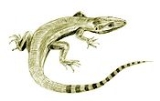
Ophiacodontidae
Encyclopedia
Ophiacodontidae were pelycosaur
synapsids. They appeared in the late Carboniferous
period. Archaeothyris
, and Clepsydrops
were among the earliest Ophiacodontids. Archaeothyris and its relatives were the members of this family. Some ophiacodonts were semi-aquatic, and few were fully aquatic
, but some were fully terrestrial like Archaeothyris. They resembled lizards in shape. They have strange, elongated skulls, they also have massive shoulder girdles, probably to provide muscle attachment to support the weight of the huge head. This family is the most primitive among synapsids and may have been ancestral to all pelycosaurs - which includes therapsids and their descendants, the mammals. By the Middle Permian, the ophiacodontids were becoming rare, and they were eventually replaced by anomodont
s, the diapsid
reptiles, and the evolving theriodont
s, and later in the Middle Permian, the Ophiacodontids became extinct.
Pelycosaur
The pelycosaurs are an informal grouping composed of basal or primitive Late Paleozoic synapsid amniotes. Some species were quite large and could grow up to 3 meters or more, although most species were much smaller...
synapsids. They appeared in the late Carboniferous
Carboniferous
The Carboniferous is a geologic period and system that extends from the end of the Devonian Period, about 359.2 ± 2.5 Mya , to the beginning of the Permian Period, about 299.0 ± 0.8 Mya . The name is derived from the Latin word for coal, carbo. Carboniferous means "coal-bearing"...
period. Archaeothyris
Archaeothyris
Archaeothyris was a very early mammal-like reptile, which lived in the late Carboniferous period. Dated to 306 million years ago, it is the oldest undisputed synapsid known....
, and Clepsydrops
Clepsydrops
Clepsydrops was a primitive amniote from the early Late Carboniferous that was related to Archaeothyris and the synapsids—the ancestors of mammals. Like many other terrestrial early amniotes, it had the diet of insects and smaller animals. It also laid eggs on land rather than in the water, as...
were among the earliest Ophiacodontids. Archaeothyris and its relatives were the members of this family. Some ophiacodonts were semi-aquatic, and few were fully aquatic
Aquatic animal
An aquatic animal is an animal, either vertebrate or invertebrate, which lives in water for most or all of its life. It may breathe air or extract its oxygen from that dissolved in water through specialised organs called gills, or directly through its skin. Natural environments and the animals that...
, but some were fully terrestrial like Archaeothyris. They resembled lizards in shape. They have strange, elongated skulls, they also have massive shoulder girdles, probably to provide muscle attachment to support the weight of the huge head. This family is the most primitive among synapsids and may have been ancestral to all pelycosaurs - which includes therapsids and their descendants, the mammals. By the Middle Permian, the ophiacodontids were becoming rare, and they were eventually replaced by anomodont
Anomodont
The Anomodontia were a major group of therapsids, an extinct group of animals commonly known as "mammal-like reptiles." They were mostly toothless herbivores. During the Middle Permian they were very diverse, including groups like the Venyukovioidea, the Dromasauria, the Dicynodontia, and early...
s, the diapsid
Diapsid
Diapsids are a group of reptiles that developed two holes in each side of their skulls, about 300 million years ago during the late Carboniferous period. Living diapsids are extremely diverse, and include all crocodiles, lizards, snakes, and tuatara...
reptiles, and the evolving theriodont
Theriodont
Theriodonts , are a major group of therapsids. They can be defined in traditional, Linnaean terms, in which case they are a suborder of mammal-like reptiles that lived from the Middle Permian to the Middle Cretaceous, or in Cladistic terms, in which case they include not only the traditional...
s, and later in the Middle Permian, the Ophiacodontids became extinct.
External links
- Ophiacodontidae - at Palaeos

